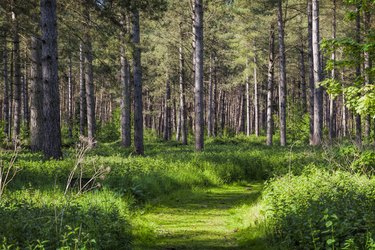
In much of the United States, Norfolk Island pines (Araucaria heterophylla) are best known as indoor houseplants or miniature holiday trees that get tossed out with the holiday wrappings. But in outdoor landscapes in U.S. Department of Agriculture plant hardiness zones 9 through 11, these ancient trees inspire awe with their size and beauty. Adaptable and low-maintenance, Norfolk Island pines flourish with minimal care.
Health-Enhancing Exposure
Video of the Day
Also known as star pine (though it's not a true pine at all), Norfolk Island pine's native habitat is the full South Pacific sun and sandy island soil of the small island near New Caledonia. But this versatile tree adapts easily to all soil types and highly acidic to slightly alkaline soil pH, as long as the soil is well-drained.
Video of the Day
The trees tolerate light shade, but too little light leads to droopy branches that detract from the tree's stately horizontal limbs. If you're shifting an indoor-grown plant to an outdoor location, move it gradually and protect its foliage from direct afternoon sun until the tree acclimates.
Ongoing Care and Nutrition
Though Norfolk Island pine tolerates dry periods, consistent soil moisture supports healthy growth. In normal outdoor growing conditions, natural rainfall meets most of the tree's water needs. During drought conditions and with outdoor container plants, use a moisture meter to monitor soil moisture by hand. Containers dry out more quickly than in-ground plantings, so watch them closely. Allow the soil to dry slightly between waterings, and then water deeply and thoroughly. To prevent disease, never leave soil soggy; water-logged soil leads to root rot. Make sure any container has adequate drainage.
Landscape-grown Norfolk Island pines don't need extra fertilizer and do well even in poor soils. Outdoor container-grown plants lose nutrients through more frequent waterings, so they benefit from fertilizer. Fertilize these trees with a dilute solution of water-soluble, all-purpose fertilizer, such as 24-8-16 plant food at a rate of 1/2 teaspoon per 1 gallon of water, adjusting this rate if label directions vary, once every two weeks.
Pruning and Protection Needs
Long-lived landscape Norfolks survive 150 years or more, growing up to 2 feet each season. These distinctive trees grow up to 200 feet tall in their native habitat on Norfolk Island. In U.S. landscapes, they regularly reach 100 feet tall and 60 feet wide. Norfolks rarely need pruning, other than removal of dead or damaged branches. If branches are lost, they won't grow back, so keep pruning to a minimum. Use sharp, bypass-style pruners, and sterilize blades with household disinfectant before and after you prune.
When grown near the limits of their hardiness, young or newly planted Norfolk Island pines need added protection from unseasonable cold. Temperatures below 40 degrees Fahrenheit damage foliage, so protect young trees with coverings when cold snaps hit. Norfolk Island pines can survive lower temperatures, but they may be killed back to the ground and grow back from the roots.
Pest and Disease Prevention
Insects and disease rarely affect outdoor Norfolk Island pines. Proper culture prevents most problems. The tree's magnificent size often makes treatment impractical, so prevention is essential. The fungal disease anthracnose affects Norfolk foliage that stays too moist. To prevent anthracnose and similar diseases, avoid overhead watering. Water in the morning, so foliage dries early and well. If garden spaces become cramped, adjust the surroundings to improve air circulation around the trees.
Scale insects and mealy bugs may affect Norfolk Island pines, but natural insect enemies generally handle these harmful pests on their own. Healthy trees withstand minor infestations, so proper preventive care is important. Limit use of pesticides to help keep beneficial insect predator and parasite populations at optimal levels. If infestations become severe, the tree may be stressed from improper culture or other problems. In these cases, you may need to call a professional pesticide applicator for effective, whole-tree treatments on mature Norfolk Island pines.